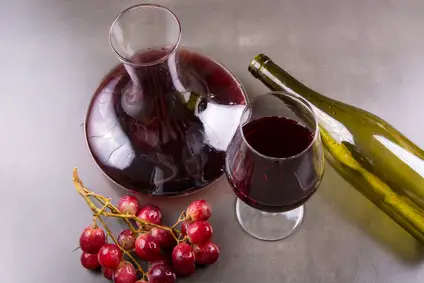Have you ever heard people talk about letting a wine breathe, but don’t really know what that means or what it does? I have and if you are reading this then you were probably like me and wasn’t entirely sure what it meant. Wine is more than just removing the cork and pouring it into a glass and drinking it. It is actually an art form that many people take seriously. So why do you let wine breathe and why does it need to breathe?
Why Do You Let Wine Breathe?
Quick Navigation
Letting wine breathe simply means that you allow the wine to be exposed to air for a period of time. When you let wine breathe, it is able to oxidize, so the flavors become softer and the aromas are released.
There are a number of wines that actually taste better when you allow them to breathe. There are some wines that can be harsh but after they have aired they become softer and more pleasant.
How to Let Wine Breathe
If you just uncork a bottle of wine, there isn’t a lot of interaction between the wine and air because of the narrow bottle neck. It is then best to aerate the wine so that you allow the wine to fully breathe.
The easiest way to aerate a wine is to simply attach an aerator to the wine bottle. This device will aerate the wine as you pour it. There are a number of aerators on the market and they do not all offer the same quality and oxygen infusion, so if you are going to get an aerator, make sure you get a good one for the best results.
Your second option is to decant the wine, which is where you will pour the whole bottle of wine into a large container called a decanter. These decanters have a small neck so that they are easy to pour from and a large surface area so the wine can become easily exposed to the air.
[responsive_video type=’youtube’ hide_related=’1′ hide_logo=’1′ hide_controls=’0′ hide_title=’0′ hide_fullscreen=’0′ autoplay=’0′]https://www.youtube.com/watch?v=PB42aVdHGWk[/responsive_video]
Your last option is to pour the wine into your glass and swirl it around before you drink it.
How Long to Let Wine Breathe?
The amount of time that a wine needs to breathe will depend on the wine. Red wines benefit from breathing just before they are served. Most wines will usually taste better after 15 to 20 minutes of aeration.
The more tannins that occur in the wine, which are usually found in the recent vintage wines, the more time it needs to breathe. With these wines, you should give them at least 30 to 40 minutes.
Wines that are older than 8 years of age, usually do not require any breathing because they may lose their flavor and are best when decanted.
White wines, champagne, rose and sparkling wines are delicate bouquets and these will not require aeration.
How to Decant a Wine
Decanting wine is a way of aerating wine, which we discussed briefly above. When you decant wine, the flavor of your wine is boosted and you will find some wines become tastier.
There are two reasons why you might choose to decant wine, the first is aeration and the second is that the wine needs to be separated from sediment that has settled over the aging period.
If you are decanting so that your wine can breathe, then you just need to simply pour your bottle of wine into the decanter. You will need to do this a certain amount of time before you intend to serve it and the time will depend on the wine you have.
If you are decanting your wine to remove sediments then you will first need to stand the bottle upright until all the sediment falls to the bottom of the bottle.
The cork will then need to be removed, but be careful not to disrupt the sediment. It is easier to see what is happening with the wine when you hold a light under the neck as you pour.
You should slowly pour the wine into your decanter and stop as soon as the sediment reaches the bottle’s neck. If the wine starts to become cloudy or if you see specks in the neck then you should stop.
So, Why Do You Let Wine Breathe?
When we allow wine to breathe we allow the flavors to develop further and the wine can become tastier. Wines that contain tannins should be aired for longer so that this taste is softer.
You can allow wine to breathe by:
- Using an aerator in the bottle
- Decanting the wine
- Swirling the wine in a glass
The amount of time that you should let a wine breathe for will depend on the wine, but an old wine will not need any breathing time and a wine with more tannins will need more time to breathe.
If you still have questions about wine and allowing it to breathe then please leave us a comment.

